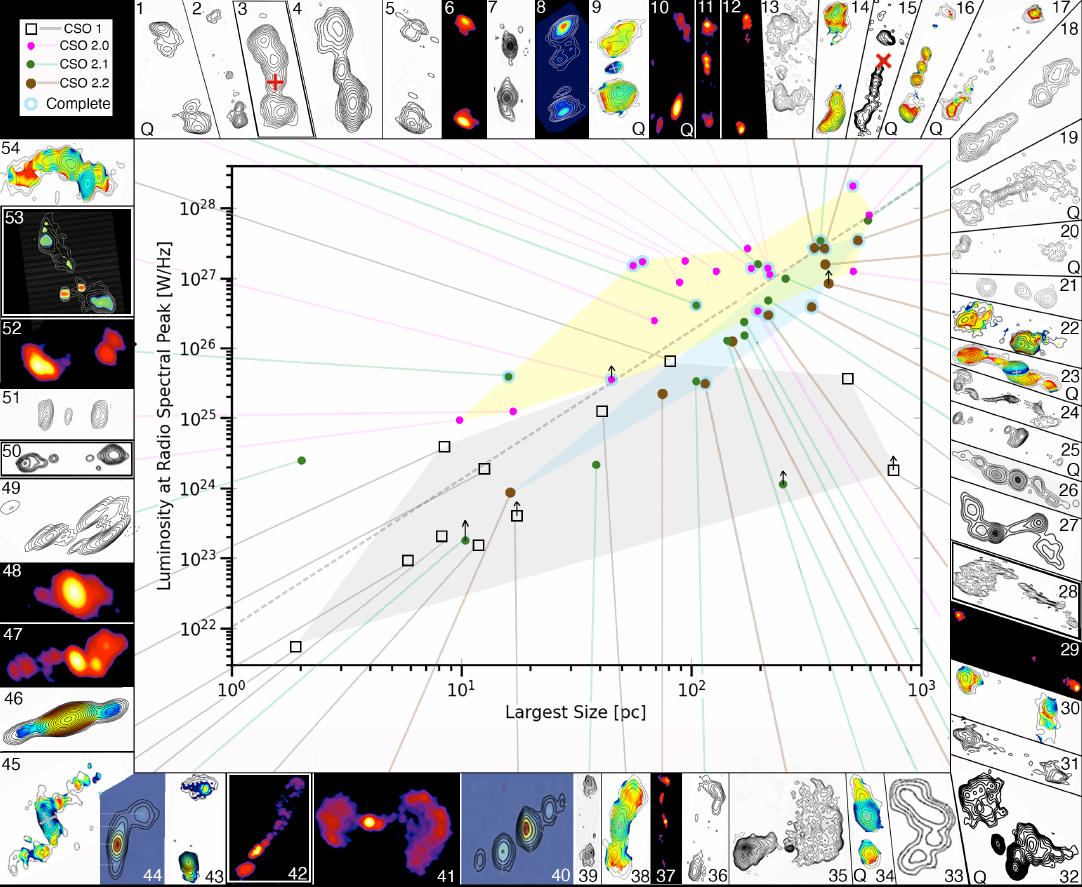Sleeping Supermassive Black Holes Awakened Briefly by Shredded Stars: Radio observations of Compact Symmetric Objects (CSOs) provide new window on black holes
Compact symmetric objects (CSOs) are active galactic nuclei (AGN) from which two jets emanate in opposite directions with an overall projected size <1kpc. These systems have often been understood as young versions of the gigantic radio galaxies like M87 that can reach sizes from kpc to Mpc. Now, reporting in a series of three papers a team of researchers, led by IA postdoctoral researcher Sebastian Kiehlmann and Anthony (Tony) Readhead, IA-FORTH honorary fellow and Caltech Robinson Professor of Astronomy, Emeritus, has concluded that CSOs are not young but rather lead relatively short lives. The researchers hypothesize that the short lifetime is a result of a limited supply of material that fuels the jets, which may originate from a single star that is shredded by the central super-massive black hole in a so called tidal disruption event (TDE). This discovery allows scientists to study the complete evolution of extragalactic jets from birth to death by examining a large sample of CSOs.
CSOs are extragalactic radio sources, where the radio emission comes from two jets that originate from a central super-massive black hole and move into opposite directions nearly at the speed of light. CSOs were originally defined as compact with a total projected size <1kpc, which distinguishes them from large radio galaxies, and symmetric, where symmetry meant to imply that relativistic beaming does not have a major effect on the emission, which distinguishes them from blazars. To ensure that CSOs indeed are not significantly beamed Kiehlmann et al, (2024a) gathered and reviewed past observations and data for more than 3,000 candidate sources from approximately 200 publications and classified these sources based on a revised set of CSO selection criteria. They verified 64 CSOs as real and identified 15 new CSOs. In addition they identified 167 candidate CSOs, whose subsequent VLBA observations are currently being analyzed.

Selected from a heterogeneous parent sample the sample of 79 CSOs is subject to various biases. Kiehlmann et al, (2024b) define a complete, flux-density limited sample of 281 radio sources that is not subject to biases, out of which 19 are in the list of 79 CSOs. Under the conservative assumption of a constant speed of advance, the authors argue that the large fraction of edge-brightened CSOs among larger size radio galaxies contradicts the hypothesis that all CSOs will eventually grow into sources substantially larger than 1kpc. Furthermore, the researchers show that the redshift distributions of the CSOs and non-CSOs in the complete sample are unlikely the same, with edge-brightened CSOs only appearing in significant numbers at redshifts <1, towards the end of the epoch of maximum galaxy and star formation. Finally, the authors show that the physical size distribution of edge-brightened CSOs does not extend uniformly up to the defined limit of 1kpc, but cuts off substantially below at around 500pc. These three independent lines of evidence suggest that edge-brightened CSOs form a class of jetted AGN that is distinct from larger size jetted sources and that the majority of CSOs does not grow into larger radio galaxies.
Out of the sample of 79 CSOs, 54 have known spectroscopic redshifts. Readhead et al, (2024) classified those 54 CSOs into 11 edge-dimmed CSO 1s and 43 edge-dimmed CSO 2s. The CSO 2s were further classified as CSO 2.0s having prominent hot-spots at the end of the jets or narrow lobes, CSO 2.2s with broad jets and/or lobes, and CSO 2.1s, an intermediate class. The four classes populate different regions in the P-D-plane that plots the luminosity (P) at the radio spectral peak against the largest linear size (D). In particular, CSO 2.0s are on average smaller and brighter than CSO 2.2s. The authors suggest that the three CSO 2 classes correspond to different evolutionary stages: CSO 2.0s being early-life sources that are still fueled and expanding, CSO 2.1s an intermediate mid-life stage, and CSO 2.2s being late-life sources, where the fueling has died off. Therefore, CSOs are not generally „young“ as often stated in the literature, because the majority does not evolve into large radio sources, rather they move through their entire life-cycle as CSOs. In comparison to large radio sources such as Cygnus A that can be tens of millions of years old, CSO 2s are „short lived“ with ages <5000 years. The authors propose that a TDE could provide a single, isolated fueling event that would explain the cutoff in size and age of CSO 2s. They show that the disruption of a massive star can provide the energy to fuel a CSO 2 on the time scale of a few 1000 years and they argue that the birthrates of CSO 2s are consistent with the expectations from TDE rates.
These three studies show that CSOs provide a unique window into the study of relativistic jets from birth to death, super-massive black holes and the accretion process. Similar to stars, whose evolution can be studied in the Hertzsprung-Russel-Diagram, the evolution of CSOs can be traced in the luminosity-size-plane. The researchers have already started programs that will increase the number of known CSOs to test the proposed hypotheses and to gain more insights into the evolution of jets.
A video which shows schematically the formation of a CSO is presented bellow:
- Kiehlmann et al. "Compact Symmetric Objects. I. Toward a Comprehensive Bona Fide Catalog“, 2024, The Astrophysical Journal, DOI 10.3847/1538-4357/ad0c56.
- Kiehlmann et al. "Compact Symmetric Objects. II. Confirmation of a Distinct Population of High-luminosity Jetted Active Galaxies“, 2024, The Astrophysical Journal, DOI 10.3847/1538-4357/ad0cc2.
- Readhead et al. "Compact Symmetric Objects. III. Evolution of the High-luminosity Branch and a Possible Connection with Tidal Disruption Events“, 2024, The Astrophysical Journal, DOI 10.3847/1538-4357/ad0c55.
